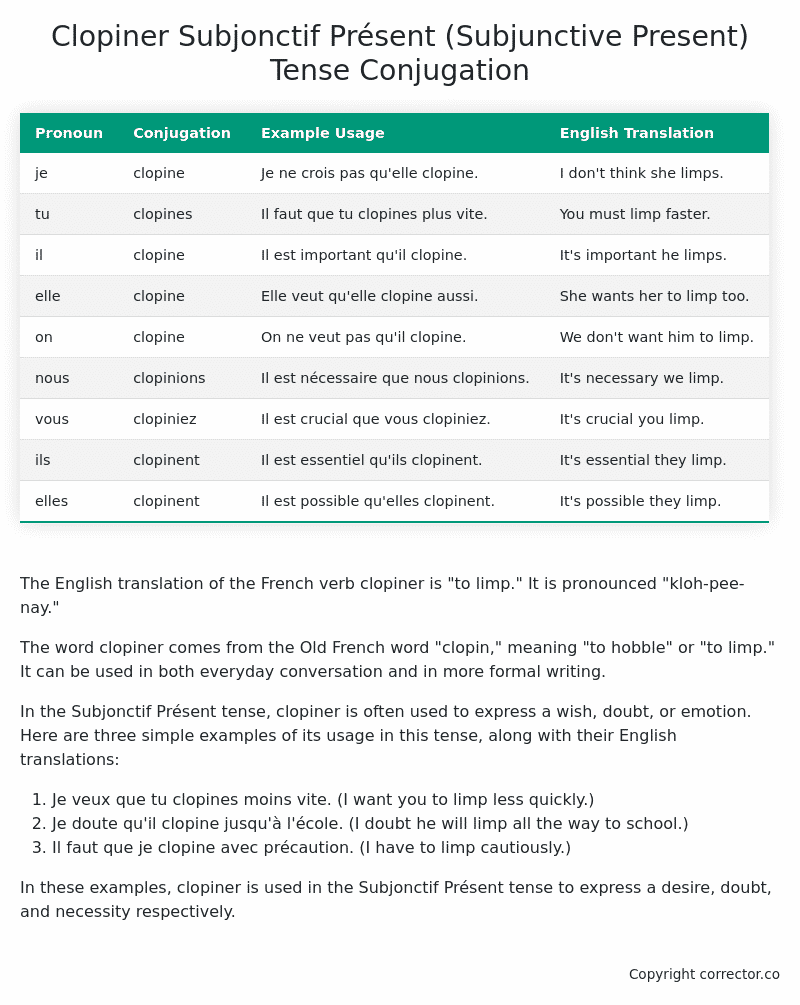Subjonctif Présent (Subjunctive Present) Tense Conjugation of the French Verb clopiner
Introduction to the verb clopiner
The English translation of the French verb clopiner is “to limp.” It is pronounced “kloh-pee-nay.”
The word clopiner comes from the Old French word “clopin,” meaning “to hobble” or “to limp.” It can be used in both everyday conversation and in more formal writing.
In the Subjonctif Présent tense, clopiner is often used to express a wish, doubt, or emotion. Here are three simple examples of its usage in this tense, along with their English translations:
- Je veux que tu clopines moins vite. (I want you to limp less quickly.)
- Je doute qu’il clopine jusqu’à l’école. (I doubt he will limp all the way to school.)
- Il faut que je clopine avec précaution. (I have to limp cautiously.)
In these examples, clopiner is used in the Subjonctif Présent tense to express a desire, doubt, and necessity respectively.
Table of the Subjonctif Présent (Subjunctive Present) Tense Conjugation of clopiner
| Pronoun | Conjugation | Example Usage | English Translation |
|---|---|---|---|
| je | clopine | Je ne crois pas qu’elle clopine. | I don’t think she limps. |
| tu | clopines | Il faut que tu clopines plus vite. | You must limp faster. |
| il | clopine | Il est important qu’il clopine. | It’s important he limps. |
| elle | clopine | Elle veut qu’elle clopine aussi. | She wants her to limp too. |
| on | clopine | On ne veut pas qu’il clopine. | We don’t want him to limp. |
| nous | clopinions | Il est nécessaire que nous clopinions. | It’s necessary we limp. |
| vous | clopiniez | Il est crucial que vous clopiniez. | It’s crucial you limp. |
| ils | clopinent | Il est essentiel qu’ils clopinent. | It’s essential they limp. |
| elles | clopinent | Il est possible qu’elles clopinent. | It’s possible they limp. |
Other Conjugations for Clopiner.
Le Present (Present Tense) Conjugation of the French Verb clopiner
Imparfait (Imperfect) Tense Conjugation of the French Verb clopiner
Passé Simple (Simple Past) Tense Conjugation of the French Verb clopiner
Passé Composé (Present Perfect) Tense Conjugation of the French Verb clopiner
Futur Simple (Simple Future) Tense Conjugation of the French Verb clopiner
Futur Proche (Near Future) Tense Conjugation of the French Verb clopiner
Plus-que-parfait (Pluperfect) Tense Conjugation of the French Verb clopiner
Passé Antérieur (Past Anterior) Tense Conjugation of the French Verb clopiner
Futur Antérieur (Future Anterior) Tense Conjugation of the French Verb clopiner
Subjonctif Présent (Subjunctive Present) Tense Conjugation of the French Verb clopiner (this article)
Subjonctif Passé (Subjunctive Past) Tense Conjugation of the French Verb clopiner
Subjonctif Imparfait (Subjunctive Imperfect) Tense Conjugation of the French Verb clopiner
Subjonctif Plus-que-parfait (Subjunctive Pluperfect) Tense Conjugation of the French Verb clopiner
Conditionnel Présent (Conditional Present) Tense Conjugation of the French Verb clopiner
Conditionnel Passé (Conditional Past) Tense Conjugation of the French Verb clopiner
L’impératif Présent (Imperative Present) Tense Conjugation of the French Verb clopiner
L’infinitif Présent (Infinitive Present) Tense Conjugation of the French Verb clopiner
Struggling with French verbs or the language in general? Why not use our free French Grammar Checker – no registration required!
Get a FREE Download Study Sheet of this Conjugation 🔥
Simply right click the image below, click “save image” and get your free reference for the clopiner Subjonctif Présent tense conjugation!

Clopiner – About the French Subjonctif Présent (Subjunctive Present) Tense
Formation of the Subjonctif Présent
Common Everyday Usage Patterns
Interactions with Other Tenses
Summary
I hope you enjoyed this article on the verb clopiner. Still in a learning mood? Check out another TOTALLY random French verb conjugation!


